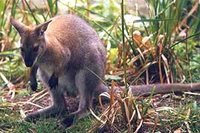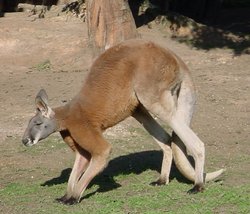Macropod
|
|
| Macropods | ||||||||||||
|---|---|---|---|---|---|---|---|---|---|---|---|---|
 Red-necked Wallaby | ||||||||||||
| Scientific classification | ||||||||||||
|
Macropods are marsupials belonging to the family Macropodidae, which includes kangaroos, wallabies, tree kangaroos, pademelons, and several others.
Macropods are herbivorous: some are browsers, but most are grazers and are equipped with appropriately specialised teeth for cropping and grinding up fibrous plants, in particular grasses and sedges. In general, macropods have a broad, straight row of cutting teeth at the front of the mouth, no canine teeth, and a gap before the molars. The molars are large and, unusually, do not appear all at once but a pair at a time at the back of the mouth as the animal ages, eventually becoming worn down by the tough, abrasive grasses and falling out. Most species have four molars and, when the last pair is too worn to be of use, they starve.
Like the eutherian ruminants of the northern hemisphere (horses, cattle, and so on), macropods have specialised digestive systems that use a high concentration of bacteria to break down plant material. The details of organisation are quite different, but the end result is very similar.
Macropods vary in size considerably but most have very large hind legs and a long, powerfully muscled tail. The term macropod comes from the Greek for "long foot" and is appropriate: most have a very long, narrow hind foot with a distinctive arrangement of toes: the fourth toe is very large and strong, the fifth toe moderately so, the second and third are fused and the first toe is usually missing. The short front legs have five separate digits. All have fairly relatively small heads with large ears. The young are born very small and the pouch opens forward.
Eastern-Grey-Kangaroo.jpg
The unusual development of the hind legs is optimised for economical long distance travel at fairly high speed. The famous kangaroo hop is not simply a matter of having strong legs: kangaroos and wallabies have a unique ability to store elastic strain energy in their tendons. In consequence, most of the energy required for each hop is provided "free" by the spring action of the tendons (rather than by muscular effort). The main limitation on a macropod's ability to leap is not the strength of the muscles in the hindquarters: the greatly elongated foot provides enormous leverage and the key factor is the ability of the joints and tendons to stand up under the strain of hopping.
In addition, there is a linkage between the hopping action and breathing. As the feet leave the ground, air is expelled from the lungs by what amounts to an internal piston; bringing the feet forward ready for landing fills the lungs again, providing further energy efficiency. Studies of kangaroos and wallabies have demonstrated that, beyond the minimum energy expenditure required to hop at all, increased speed requires very little extra effort (much less than the same speed increase in, say, a horse, a dog, or a human), and also that little extra energy is required to carry extra weight—something that is of obvious importance to females carrying large pouch young.
The ability of larger macropods to survive on poor-quality, low-energy feed, and to travel long distances at high speed without great energy expenditure (to reach fresh food supplies or waterholes, and to escape predators) has been crucial to their evolutionary success on a continent that, because of soil fertility and low, unpredictable average rainfall, offers only very limited primary plant productivity.
There are two subfamilies in the Macropodidae family: the Sthenurinae was highly successful in the Pleistocene but is now represented by just a single species, and a vulnerable one at that, the Banded Hare-Wallaby; the remainder, about 44 species, makes up the subfamily Macropodinae.
- Subfamily Sthenurinae
- Banded Hare-Wallaby, Lagostrophus fasciatus
- Subfamily Macropodinae
- Typical kangaroos and wallabies
- Agile Wallaby: Macropus agilis
- Antilopine Wallaroo: Macropus antilopinus
- Black Wallaroo: Macropus bernadus
- Black-striped Wallaby: Macropus dorsalis
- Tammar Wallaby: Macropus eugenii
- Western Grey Kangaroo: Macropus fuliginosus
- Eastern Grey Kangaroo: Macropus giganteus
- Toolache Wallaby: Macropus greyii (extinct)
- Western Brush Wallaby: Macropus irma
- Parma Wallaby: Macropus parma (rediscovered, thought extinct for 100 years)
- Whiptail Wallaby: Macropus parryi
- Common Wallaroo or Euro: Macropus robustus
- Red-necked Wallaby: Macropus rufogrisseus
- Red Kangaroo: Macropus rufus
- Black Wallaby or Swamp Wallaby: Wallabia bicolor
- Rock wallabies, pademelons and Quokka
- Allied Rock Wallaby: Petrogale assimilis
- Short-eared Rock Wallaby: Petrogale brachyotis
- Monjon: Petrogale burbidgei
- Cape York Rock Wallaby: Petrogale coenensis
- Nabarlek: Petrogale concinna
- Godman's Rock Wallaby: Petrogale godmani
- Unadorned Rock Wallaby: Petrogale inornata
- Herbert's Rock Wallaby: Petrogale herberti
- Black-footed Rock Wallaby: Petrogale lateralis
- Mareeba Rock Wallaby: Petrogale mareeba
- Brush-tailed Rock Wallaby: Petrogale penicillata
- Proserpine Rock Wallaby: Petrogale persephone
- Rothschild's Rock Wallaby: Petrogale rothschildi
- Sharman's Rock Wallaby: Petrogale sharmani
- Yellow-footed Rock Wallaby: Petrogale xanthopus
- Tasmanian Pademelon: Thylogale billardierii
- Red-legged Pademelon: Thylogale stigmatica
- Red-necked Pademelon: Thylogale thetis
- Quokka: Setonix brachyurus
- Nailtail wallabies and hare wallabies
- Bridled Nailtail Wallaby: Onychogalea fraenata
- Crescent Nailtail Wallaby: Onychogalea lunata (extinct)
- Northern Nailtail Wallaby: Onychogalea unguifera
- Central Hare Wallaby: Lagorchestes asomatus
- Spectacled Hare Wallaby: Lagorchestes conspicillatus
- Rufous Hare Wallaby: Lagorchestes hirsutus
- Eastern Hare Wallaby: Lagorchestes leporides
- (Also see Banded Hare-Wallaby, Lagostrophus fasciatus)
- Tree kangaroos
- Grizzled Tree-kangaroo: Dendrolagus inustus
- Lumholtz's Tree-kangaroo: Dendrolagus lumholtzi
- Bennett's Tree-kangaroo: Dendrolagus bennettianus
- Vogelkop Tree-kangaroo: Dendrolagus ursinus
- Matschie's Tree-kangaroo: Dendrolagus matschiei
- Unicolored Tree-kangaroo: Dendrolagus dorianus
- New Guinea forest wallabies
- Lesser Forest Wallaby, Dorcopsis vanheurni
- Papuan Forest Wallaby, Dorcopsis macleayi
- Brown Dorcopsis, Dorcopsis veterum
- White-striped Dorcopsis, Dorcopsis hageni
- Black Dorcopsis, Dorcopsis atratade:Kängurus
- Typical kangaroos and wallabies

